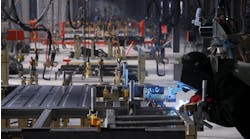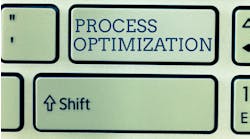By Marne Martin, president, service management business unit, IFS
As consumers become more selective about the types of brands they purchase from, a company’s sustainability commitment can become a key brand differentiator. According to the latest research, 93% of CEOs believe consumers hold a business accountable for their sustainable actions—therefore, organizations that can demonstrate their sustainability efforts beyond simple “greenwashing” will be more attractive to new and existing customers.
Further efforts to increase business sustainability however can equally benefit customers and the wider industry as a whole—with some companies leading by prime example. For instance, Google’s recent sustainability initiatives and the IFS multi-year sustainability strategy are just some of the key ways companies can set a prime sustainability example.
From our research, here are three key areas where, by rethinking supply chains, workflows and delivery cycles, manufacturers can introduce sustainable change.
1. Manage circular product lifecycles with technology-led service offerings
In a servitization model that offers state-of-the-art maintenance, manufacturing businesses can take the transactional customer-business relationship past the point of sale into the actual use of products and services. This provides an opportunity for companies to have more control over product lifecycles and ensure products continue to work optimally for customers. Manufacturers can take time to identify points of obsolescence, and remit, recycle, and rebuild products to lower the bottom-line and keep hazardous materials out of landfills. However, companies would not be able to adapt this circular approach without technological support—especially when it comes to product lifecycle management, as digital tools can scan, tag and measure wastage to help companies reduce their environmental impact.
Manufacturers can rely on enterprise-resource planning (ERP) software to help them maintain, recondition, recycle, and support the product over an extended lifecycle. ERP software incorporates environmental footprint management tools to capture the environmental footprint of the product over its lifecycle and present information for decision support. This can include the percentage of post-consumer waste used in a product and will help manufacturers see where they can maximize the reutilization of components and preempt sustainability challenges. The ability to unite operations in a single platform allows manufacturing businesses to be fully accountable and responsible for implementing sustainable practices across the entirety of their business.
2. Tailor reverse logistics value streams to optimize the repair-remittance cycle
Reverse logistics is more than parts management in reverse—it’s a microcosm of service in and of itself. For most businesses, it involves removing an asset or part from a customer, the act of repair or replacement, and then getting that part back. But with the advent of the circular economy, more manufacturing companies are challenged with managing this complex process. For instance, when customers’ scrapped parts are returned, remitting them appropriately becomes a unique new challenge.
Meeting the challenge of what goes where
Businesses must now consider what internal materials must be sent where, what is recyclable and how non-recyclable materials can be safely disposed of, so they don’t end up in a landfill. Manufacturing companies essentially now hold the levers of the recycling process for customers with support from a cohesive suite of ERP, enterprise asset management and field service management.
IoT and ERP = partners in the circle
To manage the repair-remittance cycle, businesses can use IoT-enabled sensors to automate everything from re-ordering to organizing returns and replacements. This collection of data enables focused asset management, which helps manufacturers avoid costly unexpected breakdowns and the associated cost of spare parts and service engineers. According to recent research, around 34% of manufacturers already believe it is extremely necessary to adopt IoT in operations. For manufacturers, IoT has become an ecosystem where software, cloud computing, and analytics tools are combined, to turn raw data from different sources into meaningful predictions and present them in easy-to-use interfaces.
ERP software can also help manufacturing businesses manage the return of scrapped parts by taking into account the new return considerations. These can range from the various methods of recognizing returning inventory, including return material authorizations, to keeping track of material returning from field service reverse logistics channels as technicians service equipment and replace parts or components. Greater control over this process allows companies to drive efficiencies and identify opportunities to implement more sustainable practices.
3. Rectify business efficiencies with AI-powered planning and scheduling solutions
The relationship between waste and reverse logistics is clear, but managing waste is equally important for planning and scheduling optimization. This level of optimization powered by AI goes beyond auto-scheduling and part recommendations, to be a launchpad for sustainability. True best-in-class optimization systems have multi-time horizon planning built-in to provide organizations with the tools to cover all elements of the service delivery process and fix business inefficiencies.
From real-time daily planning to long-term strategic planning, manufacturers can rely on this optimization engine to automate repeatable tasks, provide real-time resource adjustments that are scalable to meet the number of technicians in a service firm, and provide planning insights for a day, a season, a year, or whatever unit of measurement that is required.
Specifically, optimization systems use complex algorithms fed by vehicle, job, and location data to reroute technicians based on appointment, workforce, and external changes. This can minimize drive time, time from ticket to invoice, appointment time and stockouts—helping businesses mitigate carbon footprints, reduce fuel consumption and truck numbers on the road.
Aside from meeting operational criteria, the optimization engine can add value and might be the exact reason a customer chooses one business over another—a win-win for manufacturing businesses that are not just forward-looking with their growth, but also with their place in the natural world. The results speak for themselves—recent research shows that AI adoption helped 48 manufacturers to grow their revenue by 5% in a year.
It’s time for a permanent sustainability change
Sustainability plays a significant role for customers in terms of choosing the brand they want to buy from. Rather than a simple corporate showpiece, sustainability must become a new driving force to bring significant changes to workflows, supply chains, and delivery processes. Sustainability should become a main manufacturing focus for brands to meet customer demands, add value for employees and protect the bottom line.


